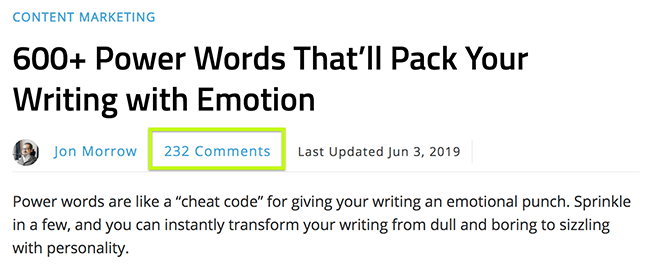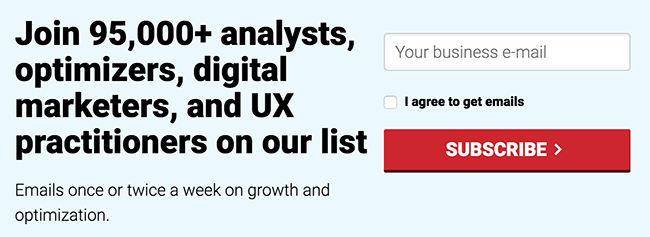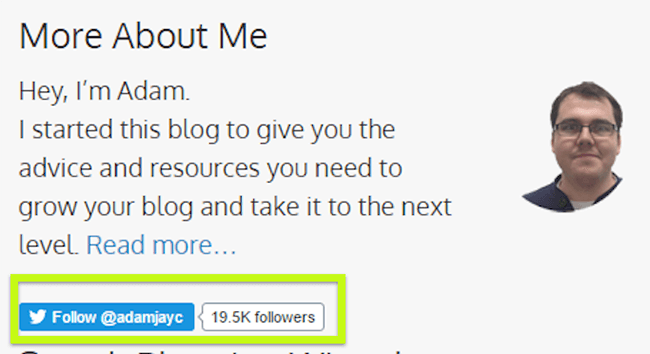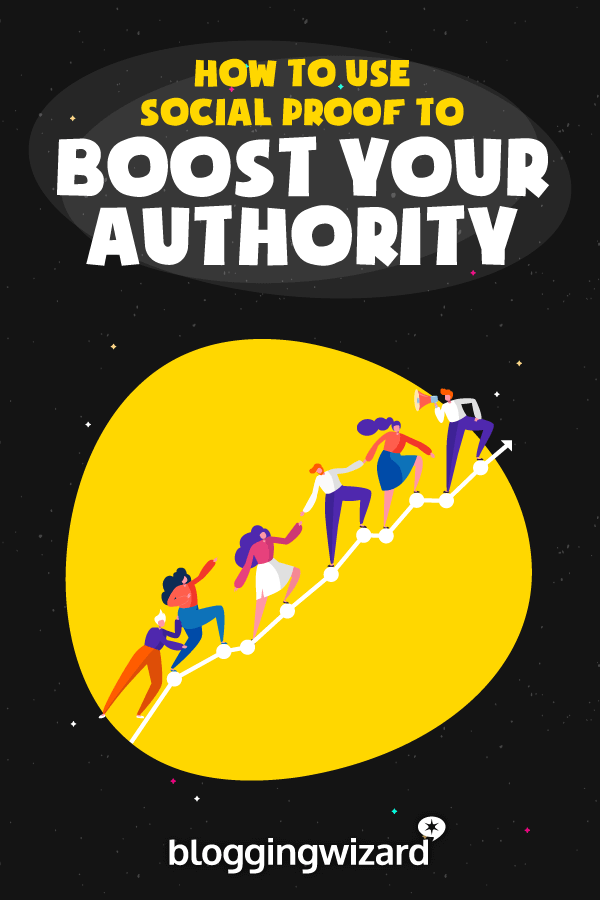How To Leverage Social Proof On Your Blog & Landing Pages

You’re a pro.
You know your stuff and more people should pay attention to what you say (and write.)
Here’s the problem:
People aren’t paying attention to what you say (yet) because you don’t have enough authority within your niche.
So, what’s the answer? Social proof.
With social proof, you gain the credibility you need to be taken seriously. And when that happens your blog’s growth will skyrocket.
But how can you leverage the power of social proof?
In this post, I’ll show you exactly what social proof is, why you should leverage it, common pitfalls to avoid, how to leverage social proof on your blog, and more.
What if you don’t have any social proof to leverage? Don’t worry! I’ll show you how to fix that towards the end of this post. It’s easier than you think.
Let’s get right to it:
What is social proof?
Social proof is a type of social influence. Wikipedia defines it as:
“…a psychological and social phenomenon wherein people copy the actions of others in an attempt to undertake behavior in a given situation.”
Here’s what this means:
Typically people will look to those around them in order to decide on a course of action. On a psychological level, we assume that if a bunch of other people are taking one course of action, that it’s the correct course of action to take.
If you’ve ever walked past a nightclub with a long queue outside and thought “wow, we should totally go there!” then, you’ve experienced social proof in action.
In the context of digital marketing, what does this look like?
Testimonials and “as seen on” logos are two prime examples of social proof.
You can see both of them in action on the Blogging Wizard homepage. And you’ll find trust logos on the homepage of my personal blog, too:

However, these aren’t the only ways you can leverage social proof. In a moment I’ll show you a lot more ways you can display social proof on your blog.
But first, we need to cover the why and a common pitfall to avoid…
Why should you leverage social proof? (And how to do it right)
When you get social proof right, you’ll easily be able to convey your authority and help to build trust with your audience.
As a result, you’ll get more traffic, email subscribers, and customers. More bloggers, writers, and journalists will mention you, and blog growth will skyrocket.
But, there’s another concept you need to be aware of: negative social proof.
While we usually refer to social proof as something positive, when you get it wrong, social proof can backfire.
Here’s an example:
If you’ve got a social media widget on your blog that shows off the fact that you’ve got 100,000 Twitter followers – that tells people that they should follow you too.
But, if you have a widget that shows off that you’ve only got 10 or so followers – that tells people that others aren’t following you, and they shouldn’t either.
So, when you’re considering which types of social proof to display, avoid anything that may be considered a negative – especially when displaying numbers.
How to display social proof on your blog
Okay, great. So, how exactly can you harness the power of social proof?
Let’s explore some options:
1. Build maximum social proof into your homepage
Your homepage is important. It’ll be the first page that a lot of people see, and it’ll be the page that most of your visitors end up going back to.
A great example is how Elna Cain adds two forms of social proof to her homepage:

Even before I had chance to scroll down the page, Elna drops some pretty significant social proof.
First we’ve got the “15,000+” people that have taken her course, and logos of sites she’s been featured on.
Here’s another example from David Hartshorne’s homepage:

Like the previous example, we see two forms of social proof above the fold (above the fold means the area of the page we see before scrolling.)
This time, we’ve got trust logos followed by a glowing testimonial from the Inbound Marketing Manager, over at Sendible.
Now, it’s important that you consider your goals. Regardless of which type of social proof you use, or where you use it, it needs to be driven by your goals.
For example, David is a freelance writer, and his homepage is optimized specifically for that goal, and the social proof he uses aligns fully too.
2. Show off how many blog comments you get
If you allow comments on your blog, and you get a lot of comments – make sure your comment counts are visible.
A great example of this is Jon Morrow’s SmartBlogger:

Jon’s post on power words has well over 200 comments which is an impressive number. Well worth showing off.
It’s worth noting that comments are harder to get than social shares, so 200 comments > 200 shares.
Similarly, if you don’t get many comments (yet), I’d recommend hiding comment counts for the time being. You may find you get more comments as a result.
3. Create a dedicated testimonial page
Aside from adding testimonials to specific pages, or opt-in forms, you can also create a dedicated page for your testimonials.
For example, that’s what freelance writer, Lindsay Liedke, does on her website:

Testimonial pages can work especially well for those offering services.
However, the process of collecting testimonials and adding them to your website can be quite time consuming. If you use WordPress, there are testimonial plugins that help with that.
For example, Thrive Ovation allows you to create a page for submitting testimonials, you can then moderate and approve testimonials that will then go to your testimonial page.
A neat feature of this plugin is its ability to pull in testimonials from blog comments and social media posts – for maximum social proof!
4. Create a dedicated press page
If you’re getting media coverage, there are a few ways to let people know about it.
One way you can do this is to create a dedicated press page.
I love how Ted Rubin does this:

He has a lot of links to articles he’s been featured in, but he also has videos of media interviews too. And those videos are incredible social proof.
5. Display social proof on your landing pages
Whether you’re creating a landing page to build your email list, you should be adding some form of social proof.
This can include testimonials, trust logos, and any data that may impress your visitors.
If this is for a new piece of content, for example, trust logos are an easy win.
For example, here’s a screenshot of a landing page I’m building for a new lead magnet:

I’m building this landing page using Leadpages, but you can accomplish something similar with most popular landing page plugins for WordPress.
6. Highlight how many email subscribers you’ve got
Got a huge email list? Wear that number as a badge of honor. You’ve earned it.
I like how ConversionXL does this with their opt-in forms:

What’s particularly great is that they’ve qualified this opt-in form with the exact sort of people who should be subscribing. If you self identify as any of those, that form becomes a lot more compelling.
And an often forgotten part of conversion rate optimization is that it’s not simply about conversion rates, it’s encouraging the right people to convert.
As a side note, if you want an easy way to create email sign up forms with WordPress, you might find my article on WordPress mailing list plugins helpful.
7. Show off the popularity of your content
Getting loads of shares on your content? Awesome!
You should definitely let people know about it.
I do this with a floating share bar:

This floating share bar was added using Social Snap, but there are quite a lot of other WordPress sharing plugins that can do something similar.
But, like I mentioned earlier, you don’t want to be displaying low share counts. In Social Snap I’m able to specify the minimum number of shares for counts to be displayed.
8. Bake some extra social proof into your footer
The footer area is one of those websites that will have the least visibility, but it has the potential to add a lot of extra value for those who take the time to scroll.
And for those, it can be a great opportunity to add some extra social proof.
A great example of this is how MenWithPens added a client testimonial to the footer of their about page:

This testimonial block seems to be used on their pages, and since it may not be as relevant for blog posts, they have a different footer for those.
Which includes some impressive trust logos:

9. Show off your traffic
Do you get a lot of traffic to your blog? It’s worth letting people know about it.
I love the simplicity of how this is done over at ZenHabits:

It’s simple, direct, and hard hitting.
10. Show off your social media following
I’m on the fence about this one because it sometimes involves making your social media accounts more prominent.
And that’s a good way to lose visitors to fail videos, cat memes, or Ron Swanson GIFs. Ok, that last one might just be me. Tweet me a Ron Swanson GIF if I’m wrong (my Twitter handle is @adamjayc.)
Anyway, here’s my point:
Generally, you’ll get more mileage out of displaying opt-in forms and building an email list. This is because email is still far better at driving traffic (although some niches do vary.)
That said, there are ways to do this without taking too much attention away from your email list. For example, using your footer.
Here’s a throwback to 2016 when I displayed a Twitter follower count in my footer:

But, I ended up removing it to minimise clutter. Now, my footer is focused on trying to draw attention to popular content. So, consider what matters most to you and find balance where possible.
How to get social proof when you’re a complete beginner
Picture this:
You’ve just started blogging. You’re writing about a topic you have expertise in.
But, to leverage social proof, you actually need some damn social proof to start with!
How do you get it?
Here are a few ideas to get you started:
1. Start guest blogging
Trust logos are one of the easiest forms of social proof to leverage.
Guest blogging is an easy way to get started.
Now, it’s important to consider that trust logos are only as helpful as the popularity of the sites you’re featured on.
Think of guest blogging like this:
Every site you contribute to is a stepping stone to bigger and more popular sites. You may not want to display the logos of the first few you contribute to, but those articles will provide samples that you can show to editors of bigger sites.
The downside to this approach is that you may end up writing a fair bit of content for other people, without getting paid. And initially, you won’t get much traffic.
That said, with a clever guest blogging strategy, it’ll pay off in the long-run.
And, if you have a sales funnel in place, you can link to your landing page in your author bio. This is how Daniel Ndukwu wrote a free guest post for Blogging Wizard and earned $1,800 in product sales. For more on sales funnels, be sure to check out our beginner’s guide.
2. Become a source for journalists
Using platforms like HARO (HelpAReporterOut), you can contribute to articles that journalists and other bloggers are working on.
It works like this: Sign up for an account and you’ll get regular emails with potential media opportunities. Reply to those that are relevant to your expertise.
I’ve used this to get mentions on sites like HuffPost, and CIO.
3. Ask for a testimonial
When it comes to getting testimonials, one of the best ways is to simply ask.
Whether it’s asking your readers if you can use their positive feedback as a testimonial, or asking other bloggers for a testimonial after you’ve written them a guest post – don’t be afraid to ask.
4. Take a strategic approach to increasing social shares
There are content distribution platforms that can help you get more shares. And Quuu Promote is one of them.
Aside from specific platforms, consider your approach to content strategy. Some content types lend themselves more to social sharing than others.
For example, reviews tend to not get much traction, while large list posts perform better. And personality quizzes take things to an entirely new level. And they can encourage people to follow you on social media, and more.
A friend of mine grew a 2-month old site to 5,000+ visitors just by using quizzes. If you use WordPress, you’ll find plenty of quiz plugins and standalone quiz makers to help you get started. And be sure to check out our tutorial on how to create personality quizzes with WordPress.
5. Run a social media contest to build your following
Back when I was running a marketing agency, I’d encourage my clients to do social media contests.
Why? They got great results time after time.
Here’s why:
People love free stuff and following your social accounts takes almost zero effort.
Before long, you can end up with a lot of new followers, providing the prize is good enough.
The best part is that you don’t even have to give anything away. Just partner up with brands in your niche, and add their social accounts as entry methods.
Now, it’s worth mentioning that people following you for free stuff aren’t the followers you want in the long-run. The point is to get the ball rolling!
You can use a free Rafflecopter account to get started. Or check out our post on social media contest tools for alternatives.
Wrapping it up
If you want your content to be taken seriously, you’ll need credibility. And that’s exactly what social proof will help you with.
Credibility allows amazing things to happen.
Your blog will grow faster, you’ll sign up more clients, and see that bank balance grow.
And for those of you looking to land a new job – social proof + blogging is a winning combo.
This isn’t about bragging. It’s about highlighting your worth. And, you’re worth a lot.
Use the advice in this post to get social proof, and leverage it on your blog.
Are you ready to put social proof to work for you? There’s no better time than now.
Let’s do this!

